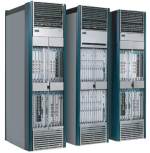An overview of BT's 21st Century Network Technology and Topology.
~ Introduction to BT's 21CN
21CN involves a huge overhaul of the existing 20CN network. Over the next few years BT will gradually be updating the existing equipment and replacing it with a new multi-service network.
The PSTN (telephone) services will be provided over the same IP network as broadband. This will involve replacing telephone switching equipment and the adsl broadband DSLAMs with MSANs (Multi-Service Access Nodes) which will terminate telephone and broadband connections.
Note: Plans to also move the telephone network over to IP has been temporary been abandonded by BT.
As well as faster speeds the new equipment will also allow BT more configuration options and allow them to offer products with QoS (Quality of Service) availability.
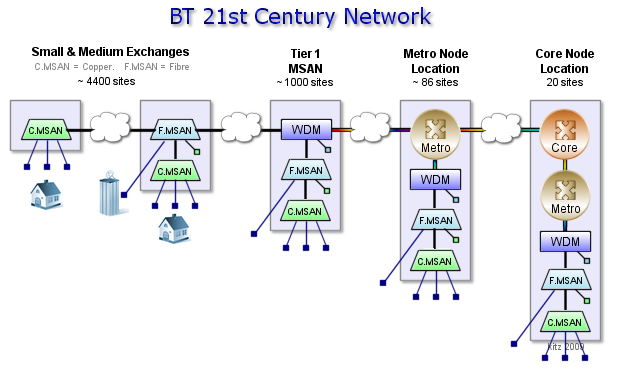
Interactive diagram depicting an overview of the network.
Hover your mouse over the various parts to find out more information.
~ Network Access - The MSAN
The MSAN (Multi Service Access Node) is the equipment in the exchange which is responsible for aggregating voice and data from the customer and for routing this traffic on to the main backhaul.
The MSAN replaces the PSTN (System X & System Y) concentrators, ISDN equipment and also the traditional adsl DSLAMS. Voice & data will come into the exchange at the Main Distribution Frame (MDF) and on to the MSAN which converts
digital or copper based analogue to an IP based network.
There are 2 different types of MSANs:
- C.MSANs - terminate copper (telephone) cables from the home.
- F.MSANs - terminate fibre optic lines from business user premises.
|
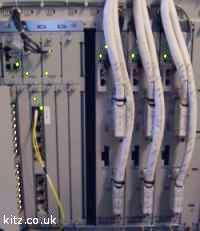
Fujitsu Geostream Access Gateway
|
BT are using Fujitsu and Huawei as the suppliers for their MSANs.
Above is a photograph of a Fujitsu Geostream Access Gateway (C.MSAN). Here you can see the switch hub on the left and some line cards on the right. The line cards perform the ATM termination. The switch hub performs traffic routing.
|

~ Exchange Backhaul from the MSAN
The backhaul transmission is SDH with Ethernet traffic encapsulated within GFP (Generic Framing Protocol) and protected using either SNCP or higher layer protection.
The network is tiered, which means that traffic will pass on up through various levels and nodes. MSANs are usually dual parented to the next level to provide some resiliency.
- C.MSAN backhaul (Tier 3): Dual parenting to Fibre Access or WDM Access nodes unless impractical
- F.MSAN backhaul (Tier 2): Dual homed. Either to WDM Access node and/or via other FMSAN(s) to WDM.
Depending upon the exchange and its size, the next tier may either be at the same location or at another exchange/PoP higher up in the chain.
Most exchanges (approx 4,400) will be Tier 2 & 3 which will be dual homed to the nearest WDM and/or via other F.MSANs to a WDM.

~ SDH & Optical Fibre Backhaul
SDH (Synchronous Digital Hierarchy) is the transport protocol used to convey multiple streams of data across optical fibre.
SDH is used by BT to form the pipes to transport data between the 21CN network nodes. Typical pipes would be 2.5 Gbps or 10Gbps although 622Mbps or 155Mbps may also be used. |
 |
SDH is flexible and allows BT to sub divide portions of bandwidth into smaller amounts or Virtual Pipes (VPs) to segregate bandwidth for service quality or for leased lines.
SDH, which was standardised in Europe, may also be referred to as Synchronous Optical Networking (SONET) in the US. |

~ Tier 1 MSANs (Wave Division Multiplexor)
Approximately 1,000 exchanges in larger towns and cities around the UK will be a designated Tier 1 location. These may also be known as a WDM MSAN physical PoP.
Each of these locations will have (many) C.MSANs & F.MSANs just like the smaller exchanges, but what makes a Tier 1 exchange different is that it will have an Access Wavelength Division Multiplexor.
The Access WDM is in itself just like a large MSAN, but they have the responsibility of taking the signals from lots of different MSANs and converting them so they are transmitted on an optical channel, thereby making the most efficient use of fibre optic cabling compared to more traditional methods.
The Wave Division Multiplexor provides the transmission functions, fibre/copper line drive and switching & aggregation functions to two Metro Nodes, the backhaul specifications are:
- Ethernet traffic will be back-hauled using Gigabit Ethernet over CWDM (or DWDM if capacity demands) to the Metro node.
- Ethernet LAG (Link Aggregation) is used for protection of Ethernet transported traffic.
Although WDM equipment & technology is expensive, its benefits are weighed not against the cost of fibre itself, but the cost of laying new fibre. Installation of WDM MSANs means that the backhaul from Tier 1 to the Core can be expanded without having to install new fibre.
Note: In total approx 1,100 locations will have access WDMs installed. 100 of these though, will actually be installed in each of the metro-nodes and Core Pops, and these additional locations are therefore designated as per their highest tier or node.

~ Wave Division Multiplexing (WDM)
Wave Division Multiplexing is a method of combining multiple signals on to optical fibre.
WDM works in a similar to Frequency Division Multiplexing (FDM) that we may be more familiar with, only rather than splitting sound/radio signals into different frequencies, WDM splits beams of light into various colour wavelengths. |
An Access Wavelength Division Multiplexor is the equipment responsible for combining signals together for transmission over the BTw Core fibre optic backhaul.
The WDM unit consists of a Signal Processing Facility (SPF), a Multiplexor (Mux) which is responsible for joining the signals at the transmitting end, and a DeMultiplexer (DeMux) which is responsible for splitting the signals at the receiving end. |
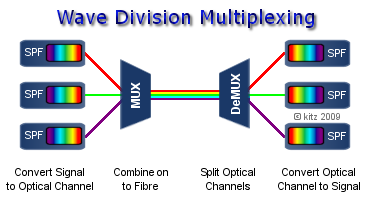 |
Utilisation of WDM technology allows a network carrier to increase the bandwidth of existing fibre without having to lay new fibre cables. BTw are using two types of WDM:-
- Coarse WDM (CWDM) - Usually 8, but up to 16 channels on a single fibre.
- Dense WDM (DWDM) - Usually 80, but up to 160 channels per optical fibre. Needs more expensive transmitter & receiver modules.
BT are/have installed WDM Multiplexors at circa 1,000 sites in the UK, to expand the existing core & backhaul capacity. |

~ 21CN Metro nodes.
There are approximately 86 designated Metro node sites in the UK. Each Metro node is dual parented to the Core PoP with 10 Gbit links. The metro nodes are a collection of large scale routers which are responsible for the IP routing and ethernet switching as well as acting as the relevant gateways for voice, data and media on to the core 21CN.
Each core node location will also have its own metro-node making a total of 106 metro PoPs.
List of known 21cn metro node locations.

~ Core Nodes
The Core nodes consist of large scale, high capacity MPLS routers supplied by Cisco and Alcatel Lucent which enable transmission speeds from 155mbit/s to 40Gbit/s using G.652 fibre cores.
The Core nodes are broken down further into 8 Inner Core and 12 Outer Core PoP locations:-
|
- Inner Core:
~ Fully meshed with other inner core PoPs via multiple 10 Gbit/s links
~ Full service functionality (Ethernet, voice, dsl etc)
~ Some with direct Internet Access
~ Some with Network Management Centres.
- Outer Core:
~ Triple Parented or more with the Inner Core
~ Partially meshed with multiple 10 Gbit/s links
~ Some sideways links
~ Full service functionality at most PoPs.
|
|

~ 21 CN Core Node Locations
The 20 BT core nodes are located at:
| Birmingham |
London North West |
| Bristol |
Manchester |
| Cardiff |
Milton Keynes |
| City of London |
Newcastle |
| Clyde Valley |
Peterborough |
| Derby |
Preston |
| Docklands |
Sheffield |
| Glasgow |
Slough |
| Guildford |
SouthBank |
| Leeds |
Wolverhampton |
Further locations may be added by BT at a later date.
 |
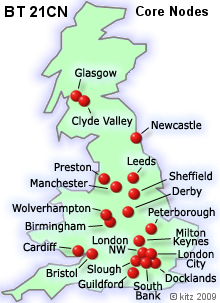
|
~ i-Nodes
The "intelligent" node which provides the service control. It is here that such things as authentication, session and profile management are carried out. There are 10 i-node locations.

~ 21CN Network topology - Summary
Inner core PoPs
• Fully Meshed - 10Gbit/s links
• 8 PoPs
Outer Core PoPs
• At least triple parented to Inner Core
• Partially meshed - 10Gbit/s links
• Some sideways links
• 12 PoPs
Metro PoPs
• Dual parented to core - 10Gbit/s links
• Circa 100 PoPs
Tier 1 MSAN PoPs
• Dual parented to Metro PoPs
• Circa 1100 sites
Tier 2 & 3 MSAN PoPs
• Dual parenting to Fibre Access or WDM Access nodes unless impractical.
• Circa 5500 sites |
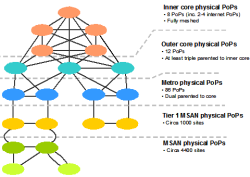
BT 21CN Network Topology
|
 |
|
|







